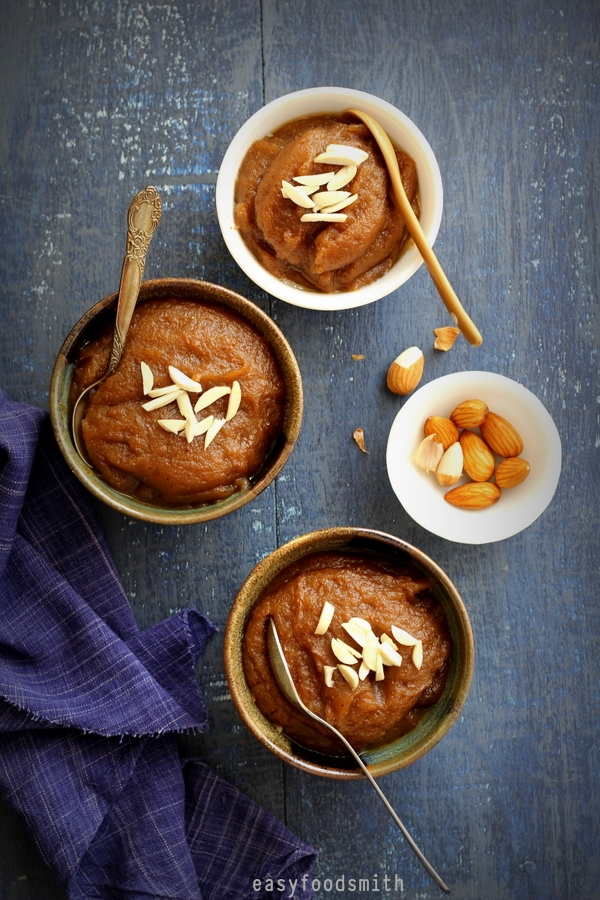
For a very long time I used to prefer Aate ka Halwa over the
Sooji Halwa; though my favourite one still remains my Mum’s
Caramel Halwa (it is insanely delicious). My love for Aate ka Halwa has perhaps to do with the fact that for the initial seven years of my schooling I was in a Sikh school where I used to participate in
kirtan programs. I was part of the choir group and we used to sing the shabads (hymn from the holy scripture namely the Guru Granth Sahib) during the morning prayers. There also used to be S
habad gaayan (hymn singing) competitions at the various
Gurudwaras in the town besides recitation on special occasions, where a group of us girls used to represent our school. At the culmination of such events we used to be served the
kadah parshaad (कड़ाहप्रशाद) which used to be the Aate ka Halwa which everyone eagerly awaited. The piping hot halwa used to be served straight in our hands and we poor kids used to keep shuffling it from one hand to another, popping a few morsels in our mouths in an attempt to finish off the hot halwa ASAP, only ending up scalding not just our hands but also our mouths. But, oh what fun it was to eat that halwa – drenched in
desi ghee, sweetened to perfection and melting in our mouths
…heavenly!

To me, a post on Aate ka Halwa without the mention of Harmandir Sahib or The Golden Temple at Amritsar is simply inconceivable. The holy Sikh shrine, built by the fifth Sikh Guru, Sri Guru Arjun Devji in the 16
th century, is surrounded by the water, i.e. the
Sarovar, on four sides and is daily visited by lakhs of visitors and pilgrims. I visited the holy shrine with my family a few years back. We enjoyed not just the
kadah prashad but also the
langar, the food at the community kitchen. The peaceful ambiance, the heavenly
prashad seemed to satiate not only our appetite but also comforted our soul. Such is my love for this halwa that I can have it hot or cold
…seriously! I often slice cold pieces of it straight from the refrigerator. Others used to find it weird since dessert such as this one, or the semolina pudding (Sooji ka Halwa) is usually eaten either hot or warm or at the most, at room temperature. It is rare to have it cold. You enjoy it whichever you like most but do give it a try.
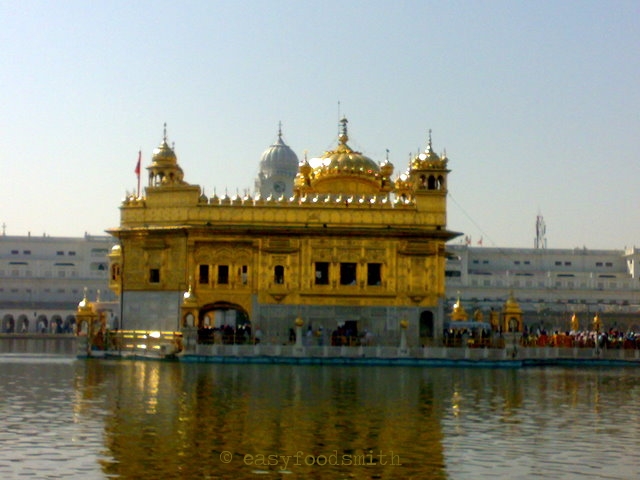
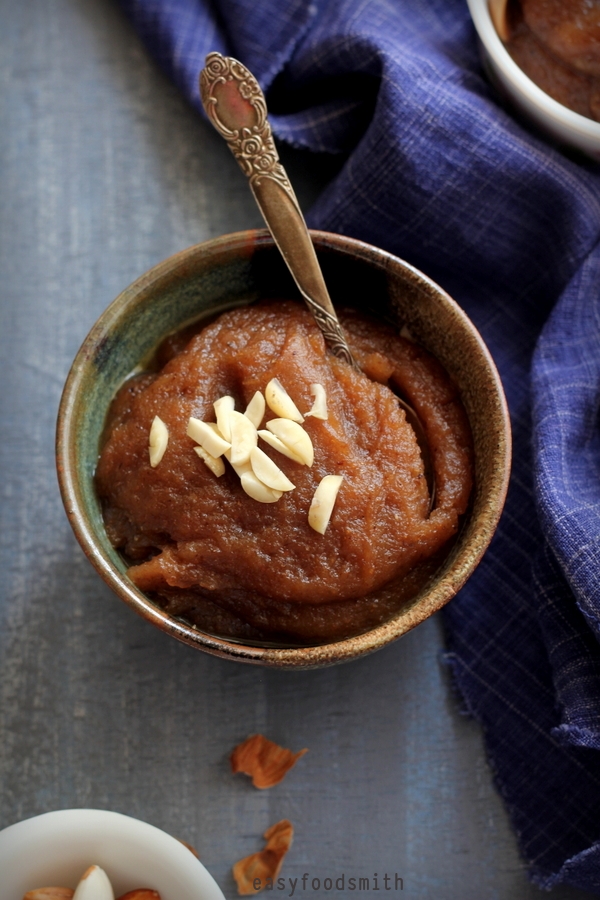
For this rich, luxurious and silken pudding you will need the following:
½ Cup + 1 tbsp Ghee
2 tbsp Wheat Bran
1 Cup Wheat Flour
4 – 5 Green Cardamom (use seeds only)
2 Cups Water
¾ – 1 Cup Sugar (adjust how sweet you like it)
A few Almonds & Raisins for garnish (optional)
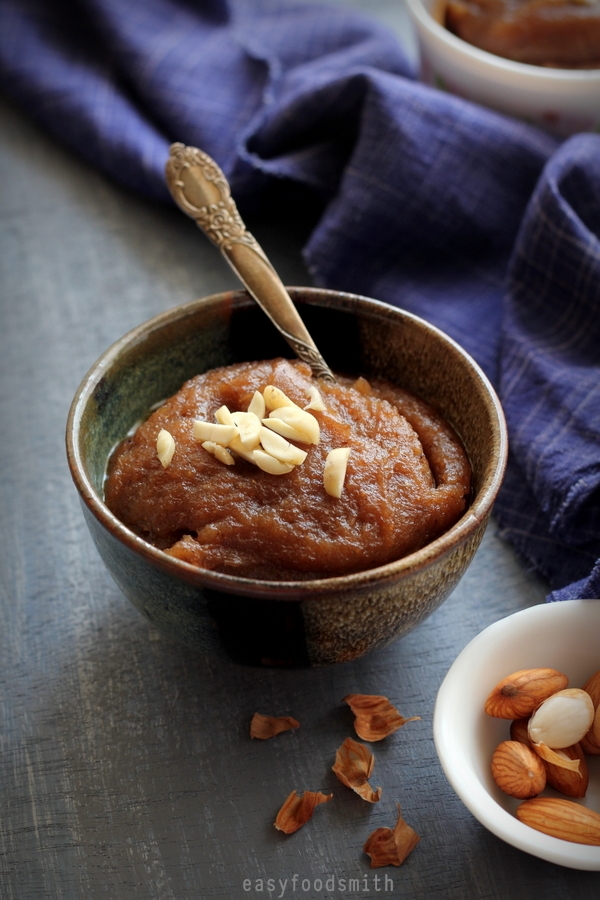
Mix together the wheat bran and wheat flour. Measure out the water and sugar separately and keep them aside, ready, before you start making the halwa.
Using a mortar and pestle, crush and slightly grind the cardamom seeds and set aside.
In a heavy bottomed pan or kadahi, heat the ghee on low heat till it melts. Add the wheat flour mix and start roasting it on a low heat. Keep stirring the flour constantly while roasting it to prevent it from burning. After roasting it for about 15 minutes you will notice the flour having changed its color and emanating a nice nutty aroma.
Keep roasting the flour further on till it acquires a nice deep brownish tone. This took me another 20 minutes.
Now, carefully tip in the water and increase the heat to medium and keep stirring the contents vigorously to avoid the flour from becoming lumpy. The halwa will start bubbling and you may want to decrease the heat to avoid any splatters.
Keep stirring till all the water is absorbed assimilated into the contents (for approx half a minute). Take care not to over cook the flour at this point else you will end up with halwa with a dense consistency. Add the sugar and switch off the heat. Stir in the sugar and let the halwa rest for a few minutes before serving. This helps the halwa develop a ‘body’.
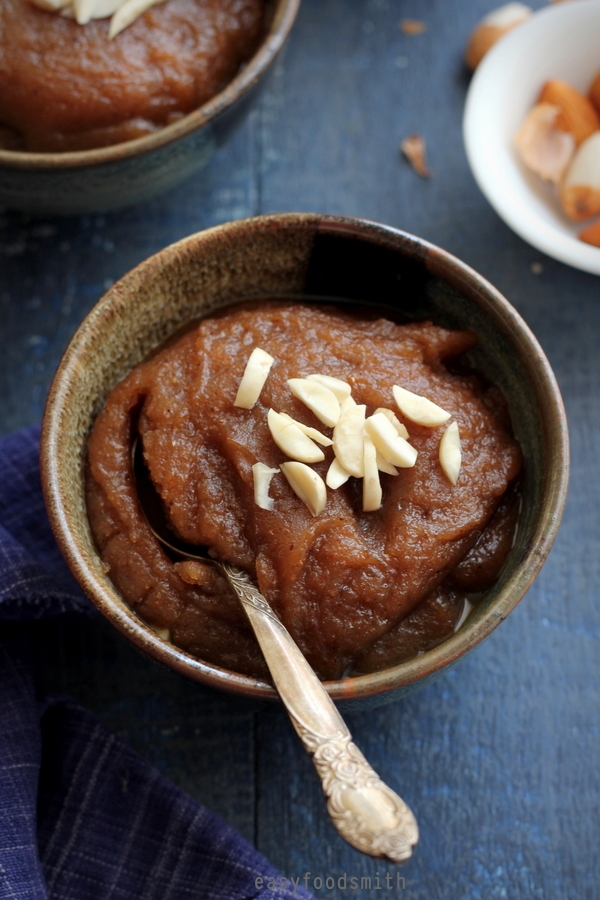
Note: While roasting the flour, do not leave it unattended at any point. For the halwa to taste good, it is essential that it is well roasted, so patience is a virtue here.
Note: I used wheat bran since I feel that the store brought branded atta lacks bran which leads to a pasty texture.
Note: The texture of the halwa will depend on the quality of wheat flour you use. If you can, try to get your hands on coarsely ground wheat flour.
Serves: 4 – 6
You may also like to check out these Indian Desserts that are to be savored essentially in winters
Petha Halwa (Spiced Pumpkin Halwa)
Badam aur Besan Laddu (Almonds & Chickpea Flour Confection) – Gluten Free
Balushahi (Indian Style Donuts)
Badam Halwa (Almond Fudge)









Oh this looks so luscious so scrumptious – I look at the ingredient list and realize you worked your magic with those ingredients to turn it into this mouthwatering pudding/halwa!
Wow, it looks simply mouth watering!! I had made the kerala style Halwa once with Jaggery and wheat flour. Like you said, it needs lot of patience to make a good tasty halwa, but its worth it. Wish I could have a big spoonful now 🙂
This is so different from the pudding I know. It surely looks very tasty!
Never know any kind of this pudding before, we used to glutinous rice flour oudding thou here in Indonesia
The first time I tried Aate ka halwa was when my friend had her baby here 16 rs ago. She taught me how to make it and boy oh boy, why did I learn. I do make it quite often because it satisfies the sweet craving in a short time and it’s absolutely delicious. It’s interesting that you’ve added wheat bran too, I will try this version out. Btw, my dad says the prashad in the Gurudwara cannot be beaten. Yum.
Have a great weekend.
Atta ka halwa looks delicious. I would love to try it. I heard it is best on Gurudwara.
Such a unique pudding—I’d love to try the caramel version!!! And such fun memories from your childhood 🙂
What a yummy dessert that is! I love the photos too.
Awesome clicks and presentation as usual dear….loved the dessert…I can smell the ghee:)
This looks amazing and like nothing I’ve ever experienced before. Wish I had a bowl right now. Beautiful photos!
The best, most delicious halwa ever. I don’t make this at home anymore because its made with wheat flour but when I get a craving I make it with chickpea flour.
Now this sounds lovely. The cardamom infusion especially!
Halwa is actually the best, my mum makes it all the time 😀
Maybe we can try your recipe together, looks delicious!
Cheers
Choc Chip Uru
Looks like a warn and intensely flavored halwa. Delicious!
Wow!!! Simply mouthwatering !! Wl definately try
I loveee aate ka halwa..oh my god it’s my favorite I want to take out one bowl from the screen and eat it right now!! looks so good Taruna! btw I tried pinning this but it won’t let me pin from your blog..any idea why?
Hi Manali! I am glad u liked this recipe 🙂
As for the pinning, sometime my blog behaves weird and refuses to listen to certain commands. I am still trying to figure out why. Another blogger friend had same problem when she tried to pin a recipe.
May be you can copy paste the URL of the recipe and proceed with pinning.
My mother used to make this, I love this stuff. I haven’t tried making it myself, but now I have a wonderful recipe. It looks wonderful, Taruna!
I would love to visit India one day and perhaps try this delicious pudding where it was born!
I never have heard or even tried a dessert quite like this before. But I do love the flavour and spice of cardamom.. so i can imagine it is delicious!
What a great comfort food treat! And, great memories of enjoying it too.
Love the combination of flavors at this elegant sweet treat.
Beautiful pictures, I wish I could travel back to India soon.
This looks incredible. I’d like mine in a bowl, though, rather than my hands — ouch! ouch! ouch! Of course no dishes to wash that way. 🙂 Really good recipe (and post!) — thanks.
That’s an incredible bowl of halwa! Wow! Very interesting tip – on using bran atta. I agree about the pasty texture….one reason why I have stopped making atta halwa lately.
This is different! I’ve never eaten anything like this; however, having made your ghee several times and I certainly imagine how absolutely wonderful this must be. Thanks for sharing such a fabulous recipe!
Wow !! Just look at that super yummy halwa..so rich and delish absolutely loved it..craving for it now…
I have eaten gajar ka halwa and lauki ka halwa. My mom makes the best Gajar Halwa. But she has never cooked something like aate ka halwa. I will share this recipe with her and hope for the same good taste as I get in her Gajar and Lauki Halwa.
Nice Recipe. Thx for sharing online.
Hello Sarika, I am sure your mother will do complete justice to this halwa as well 🙂